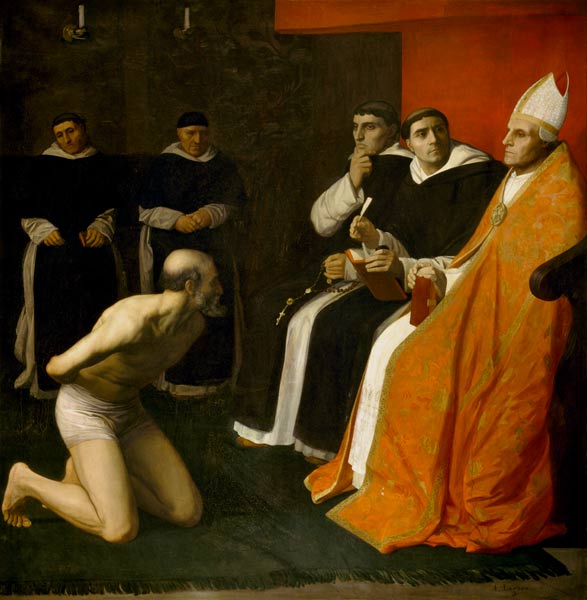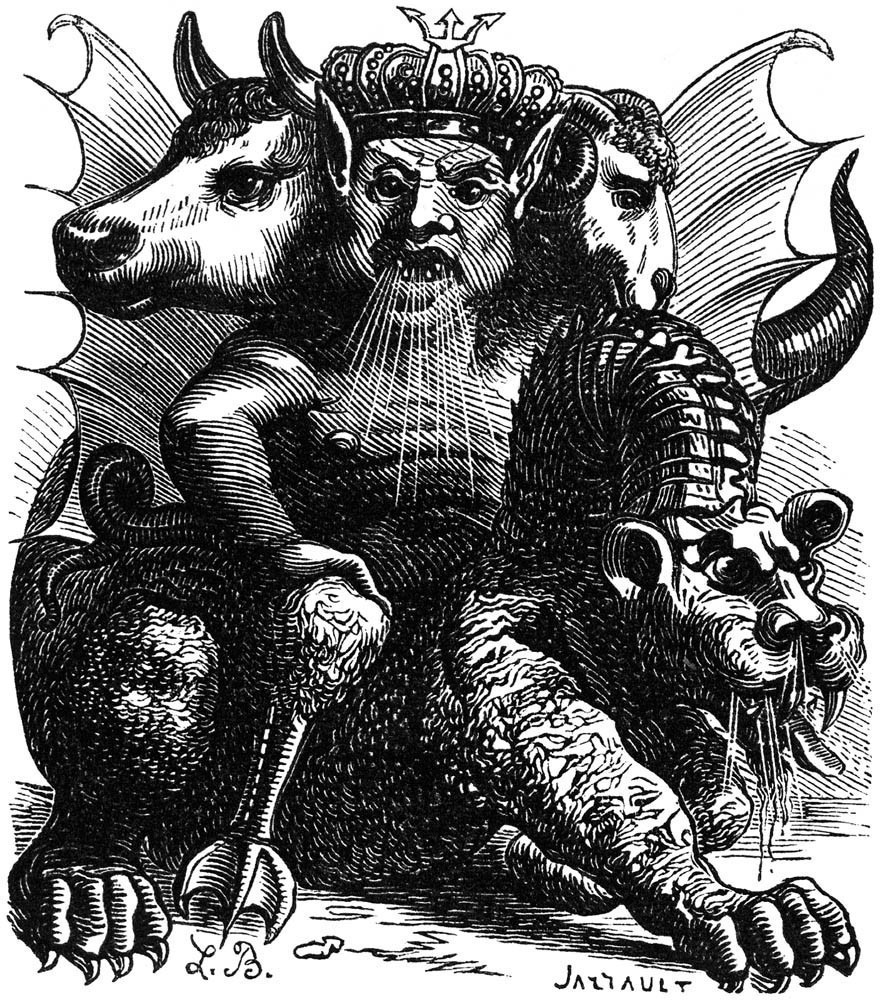|
Loudun Possessions
The Loudun possessions, known in French language, French as the Possessed of Loudun Affair (''Affaire des possédées de Loudun''), was a notorious Witch-hunt, witchcraft trial that took place in Loudun, Kingdom of France, in 1634. A convent of Ursulines, Ursuline nun, nuns said they had been visited and Spirit possession, possessed by demons. Following an investigation by the Catholic Church, a local priest named Urbain Grandier was accused of summoning the evil spirits. He was eventually convicted of the crimes of Magic (supernatural), sorcery and Death by burning, burned at the stake. The case contains similar themes to other witchcraft trials that occurred throughout western Europe in the 17th century, such as the Aix-en-Provence possessions (France) in 1611 or the Pendle witches (England) in 1612 before reaching the European colonization of the Americas, New World by the Salem witch trials, 1690s. Background In its continuing efforts to consolidate and centralize power, the C ... [...More Info...] [...Related Items...] OR: [Wikipedia] [Google] [Baidu] |
Urbain Grandier
Urbain Grandier (1590 – 18 August 1634) was a French Catholic priest who was burned at the stake after being convicted of witchcraft, following the events of the so-called "Loudun possessions". Most modern commentators have concluded that Grandier was the victim of a politically motivated persecution led by the powerful Cardinal Richelieu. The circumstances of Father Grandier's trial and execution have attracted the attention of writers Alexandre Dumas père, Eyvind Johnson, Aldous Huxley and the playwright John Whiting, filmmaker Ken Russell, composers like Krzysztof Penderecki and Peter Maxwell Davies, as well as historian Jules Michelet and various scholars of European witchcraft. Life Grandier attended the Jesuit college of La Madeleine in Bordeaux. His uncle was a priest who held some influence with the Jesuits there. They held the right to appoint the parish priest for the Church of Saint-Pierre-du-Marche in Loudun, and in 1617 chose Grandier. They also had the right t ... [...More Info...] [...Related Items...] OR: [Wikipedia] [Google] [Baidu] |
Poitou
Poitou (, , ; ; Poitevin: ''Poetou'') was a province of west-central France whose capital city was Poitiers. Both Poitou and Poitiers are named after the Pictones Gallic tribe. Geography The main historical cities are Poitiers (historical capital city), Châtellerault (France's kings' establishment in Poitou), Niort, La Roche-sur-Yon, Thouars, and Parthenay. History A marshland called the Poitevin Marsh (French ''Marais Poitevin'') is located along the Gulf of Poitou, on the west coast of France, just north of La Rochelle and west of Niort. At the conclusion of the Battle of Taillebourg in the Saintonge War, which was decisively won by the French, King Henry III of England recognized his loss of continental Plantagenet territory to France. This was ratified by the Treaty of Paris of 1259, by which King Louis annexed Normandy, Maine, Anjou, and Poitou). During the late sixteenth and early seventeenth centuries, Poitou was a hotbed of Huguenot (French Calvinist Protestan ... [...More Info...] [...Related Items...] OR: [Wikipedia] [Google] [Baidu] |
Boot (torture)
The term boot refers to a family of instruments of torture and interrogation variously designed to cause crushing injuries to the foot and/or leg. The boot has taken many forms in various places and times. Common varieties include the Spanish boot (sometimes referred to as "scarpines") and the Malay boot. One type was made of four pieces of narrow wooden board nailed together. The boards were measured to fit the victim's leg. Once the leg was enclosed, wedges would be hammered between the boards, creating pressure. The pressure would be increased until the victim confessed or lost consciousness. Newer variants have included iron vises—sometimes armed with spikes—that squeezed feet and metal frames employed red-hot. John Spreul is reported to have been tortured with two different boots. In general, the boot was a mechanically-clever torture device and was widely employed throughout Europe to extract information. Spanish boot The Spanish boot was an iron casing for the leg ... [...More Info...] [...Related Items...] OR: [Wikipedia] [Google] [Baidu] |
Amende Honorable
Amende honorable was originally a mode of punishment in France which required the offender, barefoot and stripped to his shirt, and led into a church or auditory with a torch in his hand and a rope round his neck held by the public executioner, to beg pardon on his knees of his God, his king, and his country. By acknowledging their guilt, the offender made it clear, implicitly or explicitly, that they would refrain from future misconduct and would not seek revenge. Often used as a political punishment, and sometimes as an alternative to execution, it would sometimes serve as an acknowledgement of defeat and an instrument to restore peace. The term is now used to denote a satisfactory apology or reparation. In History Origins Despite its name, the ''Amende honorable'' is a ritual of public humiliation, which origins can be traced back to the Roman ritual of ''deditio/receptio in fidem''. From the 9th to the 14th century, a punishment called ''Harmiscara'' in Latin (''Harmschar'' i ... [...More Info...] [...Related Items...] OR: [Wikipedia] [Google] [Baidu] |
Angers
Angers (, , ) is a city in western France, about southwest of Paris. It is the prefecture of the Maine-et-Loire department and was the capital of the province of Anjou until the French Revolution. The inhabitants of both the city and the province are called ''Angevins'' or, more rarely, ''Angeriens''. Angers proper covers and has a population of 154,508 inhabitants, while around 432,900 live in its metropolitan area (''aire d'attraction''). The Angers Loire Métropole is made up of 29 communes covering with 299,500 inhabitants (2018).Comparateur de territoire INSEE Not including the broader metropolitan area, Angers is the third most populous |
Archbishop Of Bordeaux
The Archdiocese of Bordeaux (–Bazas) (Latin: ''Archidioecesis Burdigalensis (–Bazensis)''; French: ''Archidiocèse de Bordeaux (–Bazas)''; Occitan: ''Archidiocèsi de Bordèu (–Vasats)'') is a Latin Church ecclesiastical territory or archdiocese of the Catholic Church in France. The episcopal see is Bordeaux, Aquitaine. It was established under the Concordat of 1802 by combining the ancient Diocese of Bordeaux (diminished by the cession of part to the Bishopric of Aire) with the greater part of the suppressed Diocese of Bazas. The Archdiocese of Bordeaux is a metropolitan see, with four suffragan dioceses in its ecclesiastical province: Dioceses of Agen, Aire and Dax, Bayonne, and Périgueux. History Constituted by the same Concordat metropolitan to the suffragan Bishoprics of Angoulême, Poitiers and La Rochelle, the see of Bordeaux received in 1822, as additional suffragans, those of Agen, withdrawn from the metropolitan of Toulouse, and the newly re-established P ... [...More Info...] [...Related Items...] OR: [Wikipedia] [Google] [Baidu] |
Asmodai
Asmodeus (; grc, Ἀσμοδαῖος, ''Asmodaios'') or Ashmedai (; he, אַשְמְדּאָי, ''ʾAšmədʾāy''; see below for other variations), is a ''prince of demons'' and hell."Asmodeus" in ''The New Encyclopædia Britannica''. Chicago: Encyclopædia Britannica Inc., 15th edn., 1992, Vol. 1, p. 635. In Judeo-Islamic lore he is the king of both daemons (jinn/''shedim'') and demons ('' divs'').Raphael Patai ''Encyclopedia of Jewish Folklore and Traditions'' Routledge 2015 page 39 Asmodeus is mostly known from the deuterocanonical Book of Tobit, in which he is the primary antagonist, or the Ars Goetia. In Peter Binsfeld's classification of demons, Asmodeus represents lust. The demon is also mentioned in some Talmudic legends; for instance, in the story of the construction of the Temple of Solomon. In Islam, he is identified with the "puppet" mentioned in the Quran, which dethroned Solomon and reigned over his kingdom until he got his kingship back. Etymology The na ... [...More Info...] [...Related Items...] OR: [Wikipedia] [Google] [Baidu] |
Plague (disease)
Plague is an infectious disease caused by the bacterium ''Yersinia pestis''. Symptoms include fever, weakness and headache. Usually this begins one to seven days after exposure. There are three forms of plague, each affecting a different part of the body and causing associated symptoms. Pneumonic plague infects the lungs, causing shortness of breath, coughing and chest pain; bubonic plague affects the lymph nodes, making them swell; and septicemic plague infects the blood and can cause tissues to turn black and die. The bubonic and septicemic forms are generally spread by flea bites or handling an infected animal, whereas pneumonic plague is generally spread between people through the air via infectious droplets. Diagnosis is typically by finding the bacterium in fluid from a lymph node, blood or sputum. Those at high risk may be vaccinated. Those exposed to a case of pneumonic plague may be treated with preventive medication. If infected, treatment is with antibiotic ... [...More Info...] [...Related Items...] OR: [Wikipedia] [Google] [Baidu] |
Jeanne Des Anges
Jeanne des Anges, also known as Jeanne de Belcier (2 February 1602 – 29 January 1665), was a French Ursuline nun in Loudun, France. She became mother superior of the convent at a young age, but is chiefly remembered as a central figure in the case of the possessed of Loudun in 1632, which led, after witch trials, to the burning at the stake of the priest Urbain Grandier two years later. Early life Jeanne de Belcier was born at Cozes in 1602, the daughter of Louis de Belcier, Baron de Cozes, and Charlotte de Goumard. An accident during childhood left her permanently disabled and she was put under the care of an aunt at the Benedictine abbey of Sainte-Marie-des-Dames. Finding the Benedictine life too hard, she returned home on the death of her aunt. In 1622 she entered the convent of Ursulines de Poitiers. She made her vows a year later taking the religious name of Jeanne des Anges. In 1627, she transferred to the new Ursuline convent at Loudun, and soon afterwards became its mo ... [...More Info...] [...Related Items...] OR: [Wikipedia] [Google] [Baidu] |
Roman Catholic Archdiocese Of Poitiers
The Roman Catholic Archdiocese of Poitiers (Latin: ''Archidioecesis Pictaviensis''; French: ''Archidiocèse de Poitiers'') is an archdiocese of the Latin Rite of the Catholic Church in France. The archepiscopal see is in the city of Poitiers. The Diocese of Poitiers includes the two Departments of Vienne and Deux-Sèvres. The Concordat of 1802 added to the see besides the ancient Diocese of Poitiers a part of the Diocese of La Rochelle and Saintes. The diocese was erected according to an unsteady tradition in the third century, as a suffragan of the Archdiocese of Bordeaux. On 13 August 1317, the diocese was subdivided by Pope John XXII, and two new dioceses, Luçon and Maillezais, were created. The diocese was elevated to the rank of an archdiocese in 2002. The archdiocese is the metropolitan of the Diocese of Angoulême, the Diocese of La Rochelle, the Diocese of Limoges, and the Diocese of Tulle. The Cathedral Church of Saint-Pierre had a chapter composed of the bishop and ... [...More Info...] [...Related Items...] OR: [Wikipedia] [Google] [Baidu] |
Cardinal Richelieu
Armand Jean du Plessis, Duke of Richelieu (; 9 September 1585 – 4 December 1642), known as Cardinal Richelieu, was a French clergyman and statesman. He was also known as ''l'Éminence rouge'', or "the Red Eminence", a term derived from the title "Eminence" applied to cardinals and the red robes that they customarily wear. Consecrated a bishop in 1607, Richelieu was appointed Foreign Secretary in 1616. He continued to rise through the hierarchy of both the Catholic Church and the French government by becoming a cardinal in 1622 and chief minister to King Louis XIII of France in 1624. He retained that office until his death in 1642, when he was succeeded by Cardinal Mazarin, whose career he had fostered. He also became engaged in a bitter dispute with the king's mother, Marie de Médicis, who had once been a close ally. Richelieu sought to consolidate royal power and restrained the power of the nobility in order to transform France into a strong centralized state. In foreig ... [...More Info...] [...Related Items...] OR: [Wikipedia] [Google] [Baidu] |







